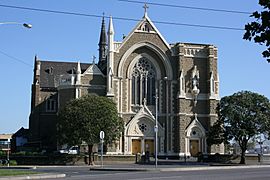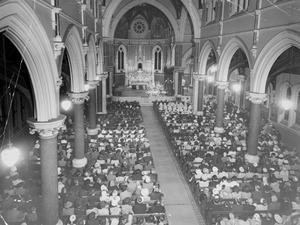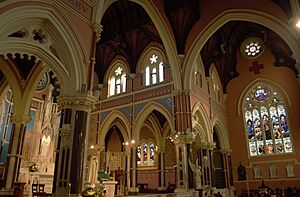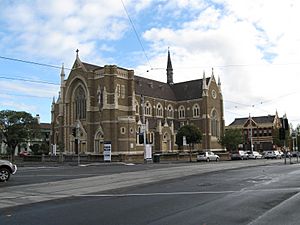St Mary Star of the Sea, West Melbourne facts for kids
Quick facts for kids St Mary Star of the Sea |
|
|---|---|

St Mary Star of the Sea, from Howard Street
|
|
| 37°48′22″S 144°57′11″E / 37.80611°S 144.95306°E | |
| Location | 235-273 Victoria Street, West Melbourne, Victoria |
| Country | Australia |
| Denomination | Roman Catholic |
| Religious order | Opus Dei |
| History | |
| Status | Church |
| Founded | June 1892 |
| Dedication | Our Lady, Star of the Sea |
| Dedicated | 18 February 1900 by Cardinal Patrick Francis Moran |
| Consecrated | 12 February 1925 by Archbishop Bartolomeo Cattaneo, Apostolic Nuncio |
| Relics held | Archdiocese Shrine of the Holy Family |
| Architecture | |
| Functional status | Active |
| Architect(s) |
|
| Architectural type | Church |
| Style | Gothic Revival |
| Years built | 1892 – 1925 |
| Specifications | |
| Length | 53 metres (175 ft) |
| Width | 29 metres (96 ft) |
| Nave width | 21 metres (68 ft) |
| Materials | Brick, stone, slate |
| Administration | |
| Parish | St Mary's Star of the Sea |
| Archdiocese | Melbourne |
St Mary Star of the Sea is a large Catholic church in West Melbourne, Victoria, Australia. Its foundation stone was placed in 1882. The main building was finished by 1900.
Since 2002, work has been ongoing to restore the church to its original beauty. It can seat over 1,200 people. Many describe it as the largest parish church in Melbourne, Victoria, or even all of Australia. The church was added to the Victorian Heritage Register on December 11, 2008.
Contents
History of St Mary's Church
Early Beginnings
On September 30, 1852, land was set aside for a church in North Melbourne. The first stone was laid on May 14, 1854. A small stone church was built within six months. It was named St Mary Star of the Sea, after the patroness of sailors. This was because Melbourne's port was close by.
As more people arrived during the Victorian Gold Rush, the number of Catholics grew quickly. In 1862, people decided to build a new, bigger church. However, there wasn't enough money. Instead, two extra sections were added to the existing church in 1871. This made the church big enough for 500 people.
In 1873, St Mary Star of the Sea became its own parish. The church building was still not big enough. More changes were made, and the inside was updated.
In 1881, plans for an even larger church were made. The foundation stone was laid in 1883. But the project stopped due to a lack of money. The new parish priest, Rev Patrick Joseph Aylward, stopped the project in 1889. He felt the planned building was too small for the growing Catholic community.
Building the Current Church
The foundations for the church you see today were laid in June 1892. A young architect named Edgar J. Henderson designed a grand church. It was planned to be 175 feet (about 53 meters) long and 94 feet (about 28 meters) wide. Some thought it was too big, but the local people loved the idea.
However, an economic downturn in 1893 made funding difficult. Despite this, the community managed to raise money. The church was built in just eight years. Phillip Kennedy took over as architect later on. His influence can be seen in the church's interior.
Henderson's design featured tall windows and a high timber ceiling. Kennedy added shiny marble and granite pillars. He also included detailed marble decorations and pink-tinted walls. These elements show an Italian influence.
On February 18, 1900, the new church was officially opened. A large crowd of 1,400 people attended. A local newspaper said the community had moved from "the worst ecclesiastical building" to "one of the finest." The church was fully completed in 1925. On February 12, Archbishop Bartolomeo Cattaneo dedicated the new marble altar.
Parish Life Through the Years
In its early days, St Mary's was mostly for Irish Australian families. During the Gold Rush, many Chinese Australians also attended. The graves of some early church members are under the nearby Queen Victoria Market.
After World War II, many new immigrants came to Australia. Italian and Maltese Australian families joined St Mary's. They brought their own traditions and ways of worship. More recently, Lithuanian and Vietnamese Australians have also become part of the church community.
Several important church leaders lived at St Mary's. Daniel Mannix was a parish priest here from 1913 to 1917. He later became a very influential archbishop. Another archbishop, Justin Simonds, also served as parish priest for 21 years. In 2001, the church was given to the priests of Opus Dei. This is a special part of the Catholic Church.
Church Restoration Project
Why Restoration Was Needed
The economic problems of the 1890s meant the church was built with lower-quality materials. The sandstone and limestone used began to wear down over time. The beautiful blue and gold patterns inside the church also faded. In the late 1950s, these colorful designs were painted over.
From the 1960s, West Melbourne became more industrial. Fewer people lived in the area, which meant fewer church members. This made it hard to pay for expensive repairs to the church's stone exterior and roof. Also, St Mary's did not get the updates that many other Catholic churches received after the Second Vatican Council. This meant its original features, like the communion rails, were kept.
By the 1990s, the outside of St Mary's was in bad shape. Parts of it were dangerously fragile. The inside was dark and looked worn out. It was clear that major work was needed.
How the Church Was Restored
In 2002, the parish priest, Rev Joseph Martins, started a big restoration project. It aimed to raise $10 million. Elias Jreissati AM led the fundraising efforts. Thomas Hazell AO helped manage the project. Dennis Payne was the main architect, working with a team skilled in old buildings. George Giannis was the chief restorer. He not only fixed what was there but also added details that were planned but never built.
For example, gold patterns were recreated in the sanctuary. Some of these patterns are like those found in Notre-Dame de Paris cathedral. Giannis's team also restored the images of St Gabriel and St Michael above the main altar. They also added a painting of Christ Pantocrator in the arch between the main hall and the altar area. Fiberglass angels were placed in niches in the ceiling, replacing wooden ones that were planned long ago.
A new marble altar was built so the priest could face the congregation during Mass. This altar was designed by Rev Victor Martinez. It weighs two tons and needed extra support underneath. Most of the inside restoration is now complete.
Many construction companies and suppliers gave their time and materials for free. Most of the money raised went to replacing the old stone on the outside walls. Over 250 tons of new stone were used on the north and east sides. Work on the west and south sides is still needed. The 2008 financial crisis affected fundraising, slowing down the work.
What the Church Looks Like
Outside the Church
The church has a traditional shape. It has a tall main hall (nave) with a pointed roof. There are also side sections (transepts) and a rounded end (apse) at the western side. The nave has lower side aisles, which allow for windows higher up.
In the north-eastern corner, there is an unfinished tower. It was meant to be 162 feet (about 50 meters) tall. The church is built of brick, covered with stone. It has a base of dark bluestone. Above this are layers of lighter limestone and sandstone.
Two types of limestone from New Zealand were used for details like doorframes and window patterns. Red granite columns are found around the windows and doors. The church roof is covered with green slate tiles from England. A tall, thin spire (flêche) sits at the center of the roof. It has decorative elements and a cross at the very top.
Inside the Church
Main Area of the Church
The church's layout is like a Latin cross. From east to west, it is 175 feet (about 53 meters) long. It is 96 feet (about 29 meters) wide from one transept to the other. The main part of the church is 68 feet (about 20 meters) wide. It includes the main hall (nave) and two side aisles. There are also small alcoves, some used as confessionals.
At the east end of the nave is the organ gallery. The original baptistery, now a chapel, is in the south-eastern corner. The main part of the church has five sections. Arches separate the nave from the aisles. These arches are supported by six red granite columns. These columns were carefully placed so they don't block the view of the main altar. Each column has a brass plate at its base. These plates show the name of the person or group who paid for that column.
Sanctuary and Chapels
St Mary's has four smaller chapels in addition to the main altar. Two chapels are next to the sanctuary. One is for the Sacred Heart and the other for the Blessed Virgin Mary. Two smaller chapels are at the front of the transepts. These are dedicated to Saints of Ireland and Saint Joseph. All these chapels and the sanctuary have rounded ends.
A white marble rail separates the sanctuary and chapels from the rest of the church. This rail was put in place in 1927. The floor of the sanctuary and chapels is covered with a marble mosaic. This mosaic was also installed in 1927. It has off-white and yellow tiles with a detailed border. The design includes symbols like a lamb, a sailing ship, and a cross.
The Organ
The church's pipe organ was built by George Fincham from 1898 to 1900. It was the first pipe organ in Australia to be recognized by the National Trust. It is considered very important for the country. It is also Australia's largest 19th-century organ that is still mostly original.
Most of Fincham's other large organs have been changed or destroyed. The organ at St Mary's was restored in 1993. It is one of the few examples of his later work that remains largely untouched.
Featured in Films
The church has appeared in movies. In 2000, it was seen in The Wog Boy. In 2007, it was featured in Ghost Rider.
Images for kids
See also
 In Spanish: Iglesia de Santa María Estrella del Mar (Melbourne) para niños
In Spanish: Iglesia de Santa María Estrella del Mar (Melbourne) para niños














